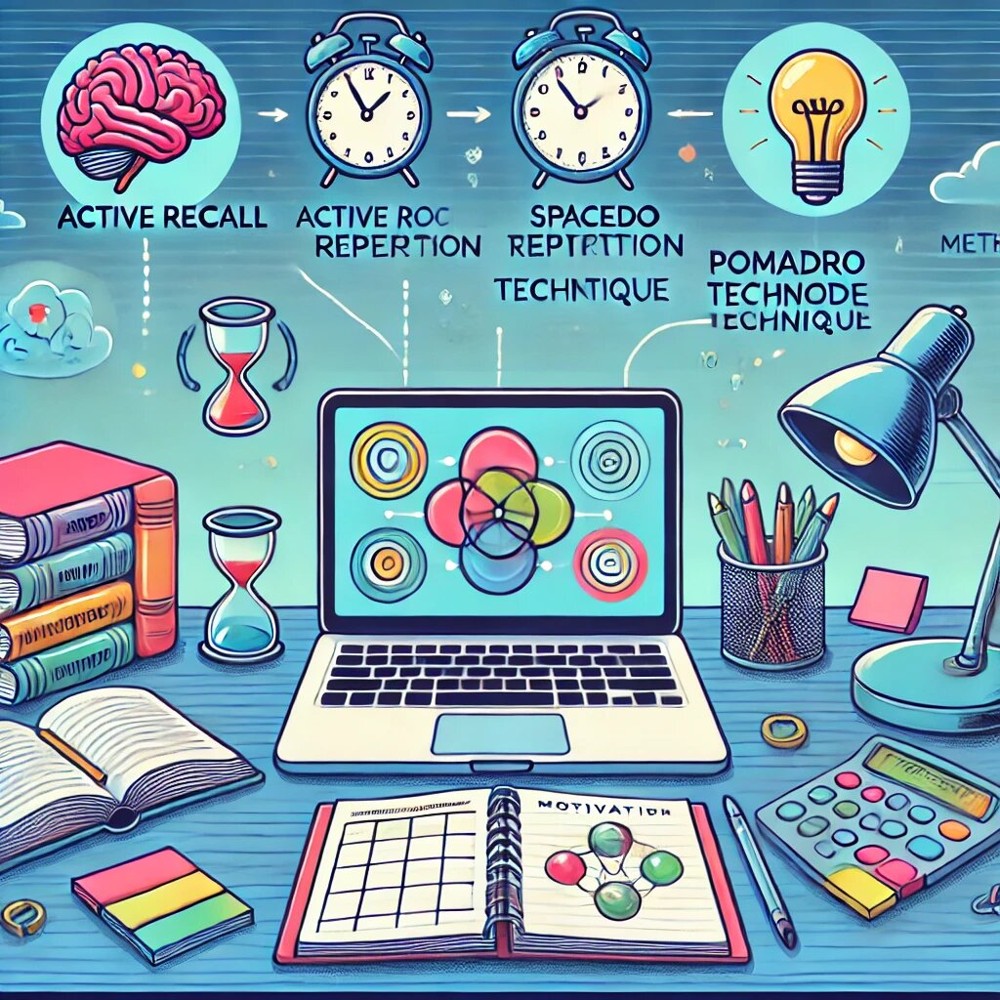Published: 4 months ago

Science
Summary
In today's fast-paced world, mastering study techniques, effective time management, note-taking strategies, and maintaining motivation are crucial for both students and professionals. These skills not only enhance productivity but also ensure a balanced and efficient approach to learning and work tasks.
Article
Effective Study Techniques
1. Active Recall Active recall is a powerful study technique that involves testing yourself on the material you have learned. Unlike passive review methods, active recall requires you to retrieve information from memory, thereby strengthening neural connections and enhancing retention.
How to Practice Active Recall:
- Use Flashcards: Write questions on one side and answers on the other. Regularly test yourself, and focus on the cards you struggle with the most.
- Teach Someone Else: Explaining concepts to others helps reinforce your understanding and identify any gaps in your knowledge.
- Self-Quizzing: Cover your notes and try to recall the information. Use bullet points or short summaries to check your understanding.
Example: If you're studying biology, instead of merely reading about cell structures, close your book and try to draw and label the parts from memory. This method ensures you actively engage with the material.
2. Spaced Repetition Spaced repetition involves reviewing material at increasing intervals. This technique leverages the psychological spacing effect, which suggests that information is better retained when it is reviewed multiple times over a spread-out period.
How to Implement Spaced Repetition:
- Digital Flashcards: Use apps like Anki or Quizlet that automate spaced repetition. These tools adjust the intervals based on how well you know each card.
- Scheduled Reviews: Schedule review sessions at different intervals, such as one day, one week, and one month after initially learning the material.
Example: If you are learning new vocabulary, review the words immediately after the lesson, then the next day, a week later, and finally after a month. This ensures the information moves from short-term to long-term memory.
3. Pomodoro Technique The Pomodoro Technique involves breaking your study time into intervals, typically 25 minutes of focused study followed by a 5-minute break. This method helps maintain high levels of concentration and prevents burnout.
How to Use the Pomodoro Technique:
- Set a Timer: Focus on one subject for 25 minutes, then take a 5-minute break to relax or stretch.
- Repeat and Rest: After four sessions, take a longer break of 15-30 minutes. This cycle keeps your mind fresh and focused.
Example: Use a kitchen timer or a Pomodoro app to set 25-minute study intervals. After each session, reward yourself with a short break, which can be a quick walk or a snack.
Time Management Tips
1. Prioritize Tasks Prioritizing tasks helps you focus on what’s most important and urgent. The Eisenhower Matrix is a great tool for this. It divides tasks into four categories: urgent and important, important but not urgent, urgent but not important, and neither urgent nor important.
How to Prioritize:
- Create a To-Do List: List all tasks and categorize them using the Eisenhower Matrix.
- Focus on High-Priority Tasks: Start with tasks that are both urgent and important, then move on to important but not urgent tasks.
Example: Imagine you have a project due in two days (urgent and important), a meeting next week (important but not urgent), responding to emails (urgent but not important), and watching a new TV series (neither urgent nor important). Focus on the project first, then prepare for the meeting.
2. Use a Planner A planner helps you organize your tasks and visualize your time. Whether you prefer a physical planner or a digital one like Google Calendar, keeping track of your schedule is essential for effective time management.
How to Use a Planner:
- Plan Weekly: Every Sunday, sit down and plan your week. Block out time for study sessions, work tasks, and personal activities.
- Daily Updates: Review and update your planner daily to adjust for any changes or new tasks.
Example: Use different colors for different types of tasks (e.g., red for urgent tasks, blue for meetings, green for personal time) to easily visualize your schedule.
3. Set SMART Goals SMART goals are Specific, Measurable, Achievable, Relevant, and Time-bound. This framework ensures your goals are clear and attainable.
How to Set SMART Goals:
- Specific: Clearly define what you want to achieve.
- Measurable: Determine how you will measure progress.
- Achievable: Ensure the goal is realistic and attainable.
- Relevant: Make sure the goal is relevant to your overall objectives.
- Time-bound: Set a deadline for achieving the goal.
Example: Instead of setting a vague goal like "study more," make it SMART: "Study biology for 30 minutes every day this week." This goal is specific, measurable, achievable, relevant, and time-bound.
Note-Taking Strategies
1. Cornell Method The Cornell Method divides your note-taking page into three sections: notes, cues, and summary. This structured format helps organize your notes and makes review sessions more efficient.
How to Use the Cornell Method:
- Notes Section: During a lecture or reading, write down the main points in the right-hand column.
- Cues Section: After class, use the left-hand column for questions, keywords, or prompts.
- Summary Section: At the bottom, summarize the main ideas in your own words.
Example: If you're attending a history lecture, jot down key events and dates in the notes section. In the cues section, write questions like "What caused the fall of the Roman Empire?" and summarize the lecture's main points at the bottom.
2. Mind Mapping Mind Mapping is a visual way to organize information. Start with a central idea and branch out with related topics. This method is especially useful for visual learners and helps in understanding the relationships between concepts.
How to Create a Mind Map:
- Central Idea: Place the main topic in the center of the page.
- Branches: Draw branches for main topics and subtopics, adding details as you go.
- Visuals: Use colors, images, and symbols to make the map more engaging and memorable.
Example: If you’re studying the causes of World War I, place "World War I" in the center. Branch out with main causes like "Alliances," "Imperialism," "Militarism," and "Nationalism," adding details and examples to each branch.
3. Highlighting and Annotating Highlighting and annotating involve marking important information and adding notes in the margins. This helps you quickly identify key points during review sessions.
How to Highlight and Annotate:
- Color Coding: Use different colors for different types of information (e.g., yellow for key concepts, blue for definitions, green for important dates).
- Marginal Notes: Write brief notes or questions in the margins to clarify points or make connections to other material.
Example: When reading a textbook, highlight key concepts in yellow, definitions in blue, and important dates in green. Write marginal notes like "compare this to..." or "why is this important?" to enhance your understanding.
Motivation Tips
1. Set Clear Goals Clear goals give you a sense of direction and purpose. Break your goals into smaller, manageable tasks to avoid feeling overwhelmed.
How to Set Clear Goals:
- Break Down Tasks: Divide larger goals into smaller steps. This makes them more manageable and less intimidating.
- Write Them Down: Keep a list of your goals and review them regularly to stay focused and motivated.
Example: If your goal is to complete a research paper, break it down into steps like "choose a topic," "conduct research," "create an outline," and "write the first draft." Tackling each step individually makes the process less daunting.
2. Reward Yourself Rewards provide positive reinforcement and make studying more enjoyable. After completing a task, treat yourself to something you enjoy, like a snack or a short break.
How to Reward Yourself:
- Small Rewards: Give yourself small rewards for completing tasks. This could be a piece of chocolate, a short walk, or watching an episode of your favorite show.
- Larger Rewards: Set larger rewards for achieving bigger milestones, like finishing a project or acing an exam.
Example: Set a reward system where you get a piece of chocolate after every 30 minutes of focused study or watch an episode of your favorite show after completing a chapter.
3. Stay Positive Maintaining a positive mindset is crucial for motivation. Focus on your progress and celebrate small victories. Surround yourself with positive influences and remind yourself of your long-term goals.
How to Stay Positive:
- Motivation Board: Create a board with quotes, pictures, and reminders of your goals. Reflect on your achievements regularly to stay motivated.
- Positive Environment: Surround yourself with positive people and influences. Avoid negative self-talk and focus on your progress.
Example: Create a motivation board with quotes like "Success is not final, failure is not fatal: It is the courage to continue that counts." Reflect on your achievements regularly and use them as fuel to keep pushing forward.
Conclusion
Mastering study techniques, time management, note-taking strategies, and staying motivated can significantly enhance your productivity and success in both academic and professional settings. By implementing these tips, you can develop effective habits that will help you achieve your goals. For more in-depth tips and resources, be sure to visit our website.
No opinions exist on this article yet!
Be the first one to share an opinion on this article.
This article does not have any attachments.
No Access
Share access to start recording your opinion











